STEELHEAD IN BRITISH COLUMBIA
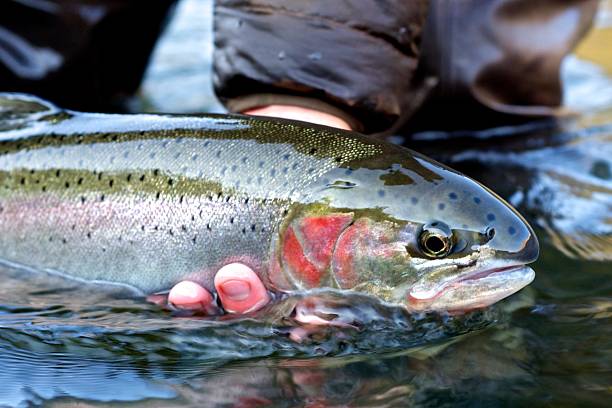
Steelhead is the name given to the great sea running rainbow trout, considered by many anglers to be the finest of sport fish. Some say commercial fishers provided the name because the fish were hard to dispatch when whacked on the head. Whether taken in October on a wet fly in Morice or Thompson, a dry fly on the Dean in August, a spoon in May in the Squamish or a spin – glo in December on the Cowichan, an encounter with a fresh run steelhead is always memorable for the angler.
Hatched and reared in the waters of western North American coastal river system, this magnificent fish migrates sea ward in its youth and grows to maturity in the energy rich waters of the North Pacific before returning to the river of its birth to spawn. Unlike salmon, steelhead do not necessarily die after spawning. Some survive and may return more than once to spawn again. Repeat spawners are rare however because he upstream migration, the spawning event and the readjustment to ocean life are strenuous and drain a great deal of the steelhead’s energy reserves.
DISTRIBUTION
When the massive ice sheets covered BC over 10,000 years ago steelhead survived in what are now Oregon, California and Northern Mexico. Imagine catching a steelhead in the Los Angeles River! As the ice retreated steelhead gradually recolonized the rivers of BC. They presently range from Central California to Alaska. They are also present in The Russian Far East on the Kamchatka Peninsula. Steelhead have been introduced to many exotic locales far beyond their native range.
Although a large portion of the4 world’s steelhead streams are located in BC, very few support large populations. Most of these streams drain small steep basins
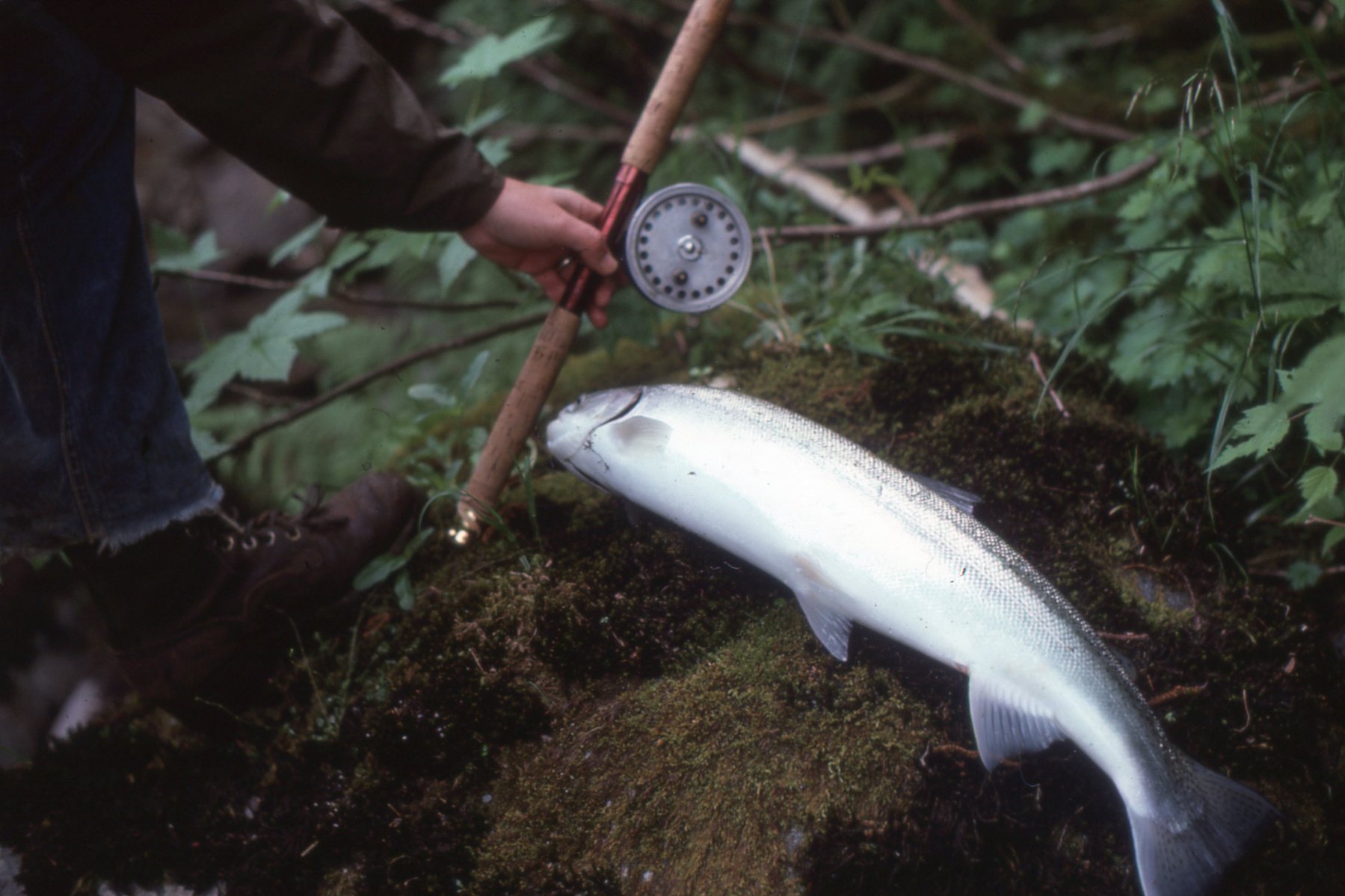
A mint summer run from the Gordon River
which are low in soil nutrients, have wild flow fluctuations and cold water for most of the year and often do not allow migratory much access due to waterfalls close to the sea.
Some exceptional systems which have lower gradients are stabilized by lakes or drain lands rich in nutrients support larger populations. The Columbia River system including the BC section once supported large numbers of steelhead. Rivers further south like the Klamath, Rogue and Umpqua still support many more steelhead than the best rivers of BC. These streams drain richer lands with more gentle weather and terrain.
BC anglers should not feel too unfortunate however. We still have many beautiful rivers to choose from that support generally large fish. We must be aware of our stream’ limitations and govern our expectations. Currently, BC steelhead are just hanging on in many rivers and catch and release regulations have become universal in our province.
LIFE HISTORY
A steelhead begins life in late winter or early spring as a pink pea sized egg buried in river gravel. As the water slowly warms, the egg hatches and slowly begins to look like a little fish. Early in the summer, it begins struggling upward to the stream as an alevin which is about half fish and half egg. The shifting of the gravel by floods and the smothering effects of sand and silt prevent most eggs from reaching this stage: of several thousand eggs deposited by the female, only a few hundred generally survive to emerge as free swimming fry about 30 mm in length.
When the fry break through to their new environment, they quickly seek out the protection and gentle current of the stream edge. They feed on small insects and hide under stones at the first sign of danger. They are highly vulnerable and many are eaten by kingfishers, mergansers and larger fish or are swept downstream by higher flows. As summer progresses, the survivors grow and move to more favourable feeding stations further out in the stream. Chances of survival are increasing now but the heat and dryness of summer take their toll of young fish. This is especially true in watersheds that have been extensively modified by man.
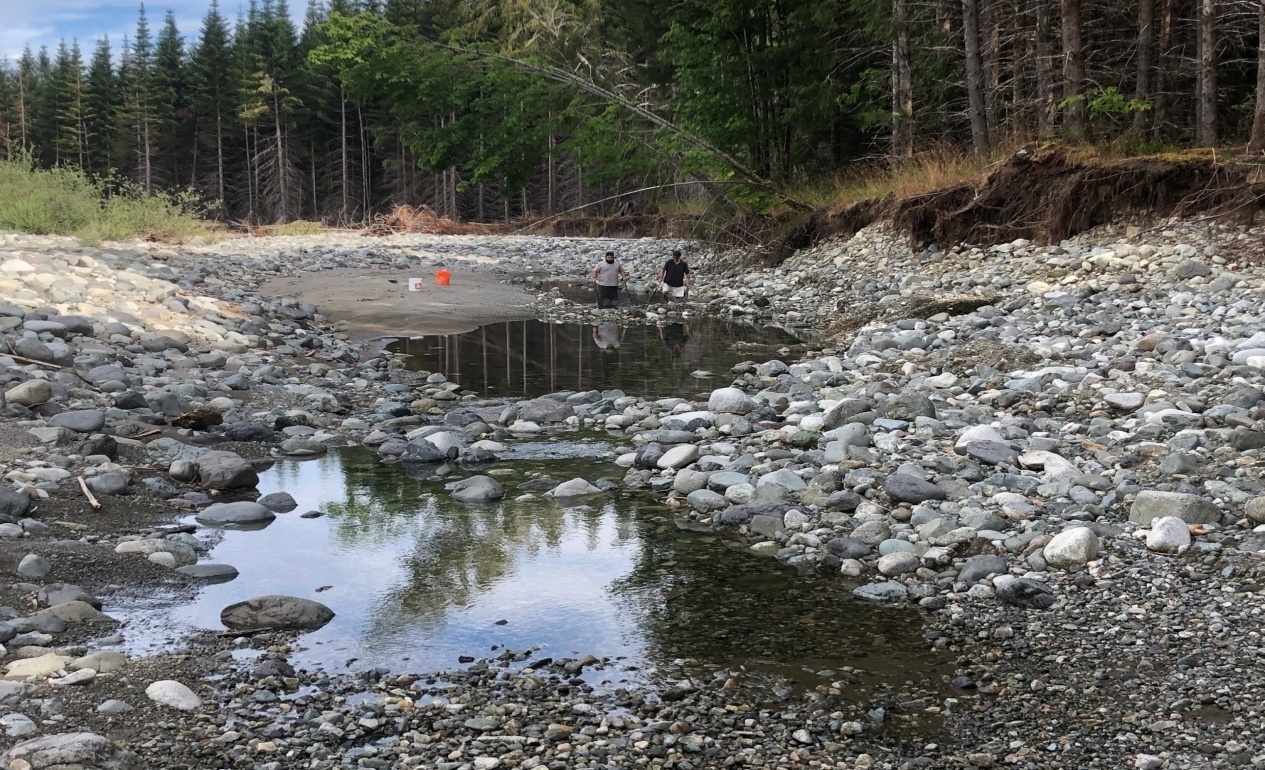
A fry salvage crew works on a drying stream
As the rain and cool nights of fall begin, the steelhead juveniles now called parr or fingerlings gradually become less active and seek out a refuge area where they can avoid the perils of winter. Because they are cold blooded their body temperature falls and they can no longer muster enough energy keep pace with the increasing current. They try and find protected off channel habitat like side channels with groundwater input, riparian wetlands or areas of log jams or over hangs and boulder gardens where they can tuck themselves in. Winter is a time of stress and mortality: the survivors are strong fish that have chosen well protected hiding places.
When the milder days of spring finally return, the young trout seek out feeding stations back in the current to regain their strength and vigour. Spring is a bountiful time on the river and the fish grow rapidly. In a few of our most productive streams, some of them are now one year old fish and are large enough to undergo the physical and chemical transformation to smolts and move down to the estuary then out to the North Pacific. But for the majority one, two or even three more years is necessary to bring them to smolt size.
The ocean environment is less hostile and offers a rich energy supply. Young steelhead are quick to take advantage and grow fast .Most of them make their way to the open sea in the Gulf of Alaska where they spend two to four years growing to be the large beautiful trout so favoured by the angler. A few fish spend the summer feeding around the home estuary. They return to the river the following winter as 30 – 40 centimetre fish.
When their physiological conditions dictate, the open ocean steelhead begin the long journey to the home river. Summer runs are the first to show sometimes as early as March. They work their way into deep canyon pools and hold there ripening and darkening until they reach full sexual maturity late in the following winter or early spring. The more common winter runs begin entering the rivers in the late fall and winter and continue until April or May.
At spring spawning time the females select sites, usually near the tail spill of a pool, to construct a red or nest to deposit her eggs. In preparing the redd, the female turns on her side and with strong tail flexes, moves the gravel and small stones to form a depression some 15 cm deep. Males fight to position themselves beside the female. When the redd is ready, both sexes settle into it and simultaneously release eggs and sperm. The female moves upstream immediately and covers the eggs with gravel then begins to excavate another red and the process is repeated. She may lay from 3000 to 15,000 eggs depending on her size.
When spawning is done, the fish are much weakened. They hold near the red for a few days then drift downstream. They are termed kelts now and are often a sorry looking lot, dark and thin with worn tails and battle scared. Some will recover and mend but most will not make it.
PAST, PRESENT AND FUTURE
BC steelhead stocks have undergone a steep decline since at least 1965. For decades, there was no information to work with. The BC Fish and Wildlife Branch began query anglers via a questionnaire in the 1960’s and that provided some clues. Anglers also began to respond in more direct ways. By the late 60’s, concerned fishermen, were expressing strong concern about the state of their resource. The province responded with more conservative regulations almost immediately and the fish started to respond. But the issue was not just one of too liberal catch, far from it. Many land use issues had driven down the fish. Logging was especially rough before the mid 1970’s but agriculture, dams, road construction and general urban development have taken a large toll. For decades BC was the land of dusty roads and ten cent beers where one could buy a good house for less than ten grand but those days are long gone. Now we have vast cities sprawling into what was wild country and five dollar beer.
The commercial fishery was also highly problematical in the steelhead decline. Some of the land use issues have improved greatly. I am especially proud of how the forest industry has improved, but commercial interception of steelhead by the salmon fishery has proven to be hugely vexing especially where the salmon runs have been enhanced and require intensive fishing to harvest them. Steelhead run in with the salmon and the fish are caught in nets which kill everything that encounters them including steelhead. General runs of salmon are also hurting so the enhanced runs are under even more pressure. Many people at much higher pay grades than I will ever see, have tangled
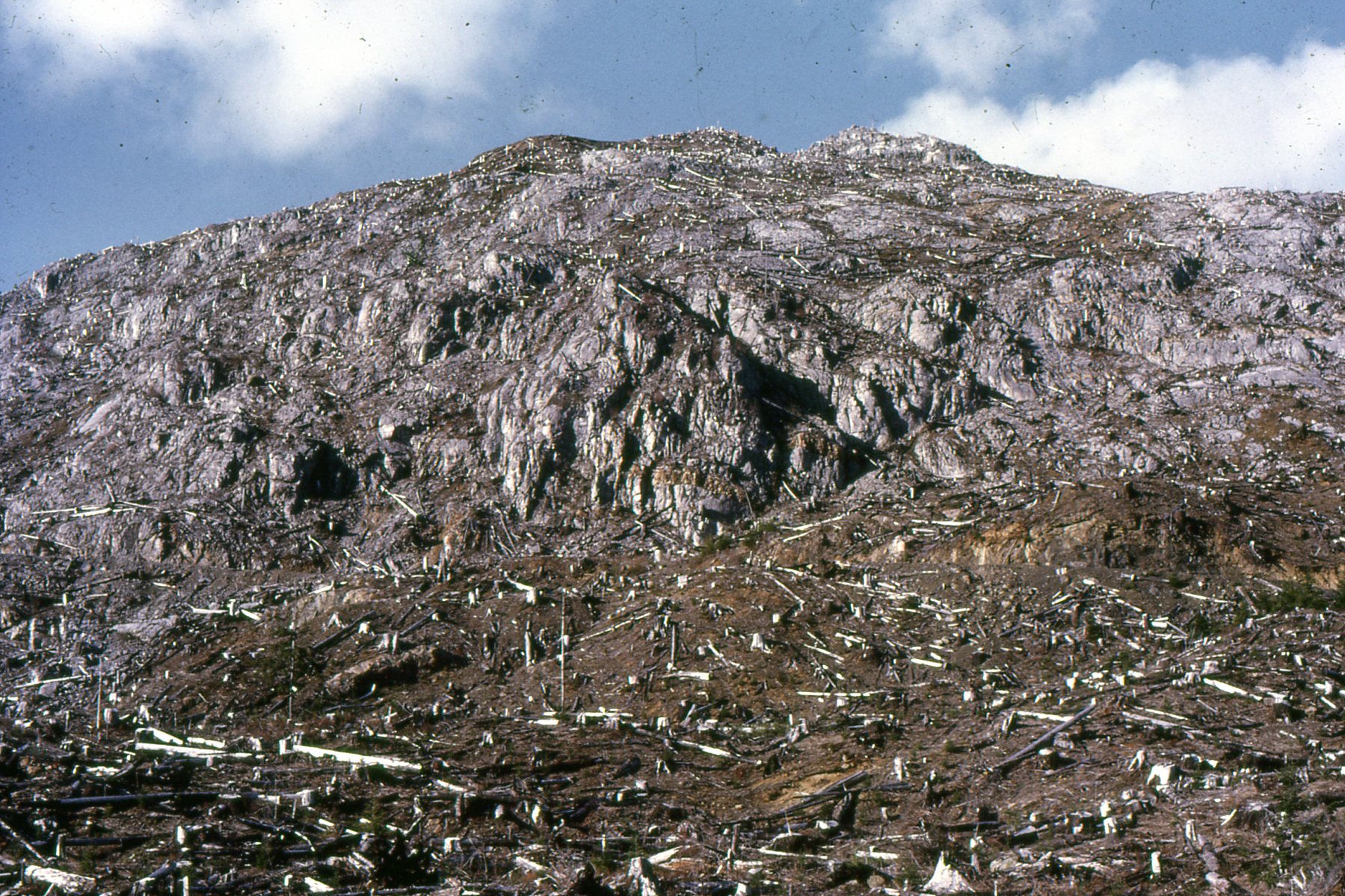
This slope on Upper Harris Creek was clear cut and slash burned – 1960’s
with this issue without much resolve. Commercial fishers are a fiercely independent, hard headed bunch who are barely hanging on themselves so it will take some kind of miracle – like intervention to solve this issue.
Every time I think of a Thompson River steelhead ending up in a net, I become enraged. And I have seen them in the native fishery near Chilliwack – lovely silver slabs hanging by their gills with the sockeye bound for the same river system.
The natives must feel about like the steelheaders but even more so because they have lost so much and it seems impossible to get more than even a shadow of it back.
I haven’t even spoken about climate issues and the changing ocean environment. Are these issues are even possible to mitigate? Before too long we all may know how the natives and the steelheaders feel. Indeed.
Ted Burns
August 2, 2020
This is a modified version of a publication called STEELHEAD TROUT IN BRITISH COLUMBIA published by the BC Ministry of Environment in 1981. It was written by me and featured photos by Eric Carlisle and Tony Pletcher and art work by Jack Grundle,
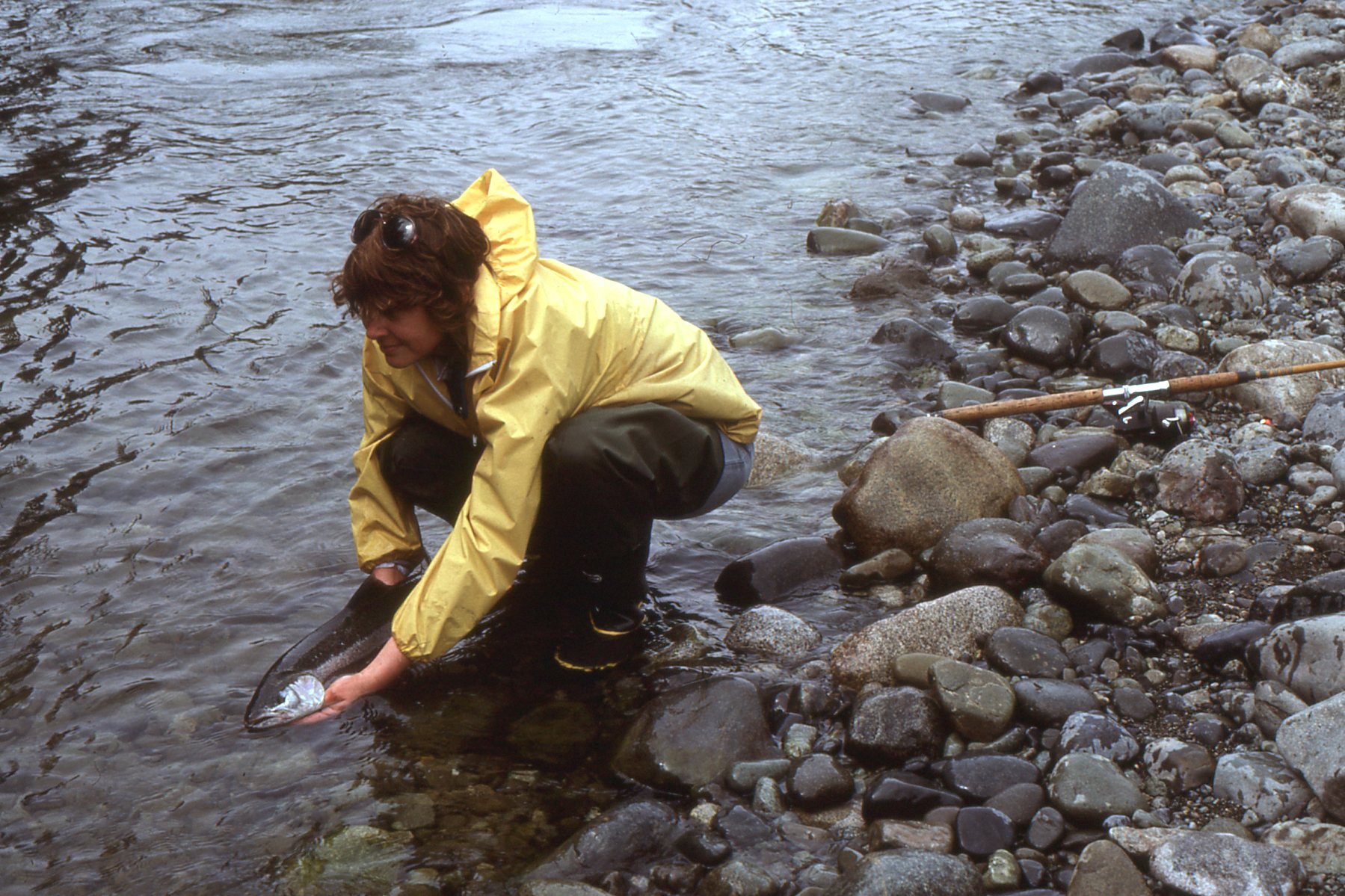
Girl releases a Cowichan River steelhead
Tags: cherished fish at risk